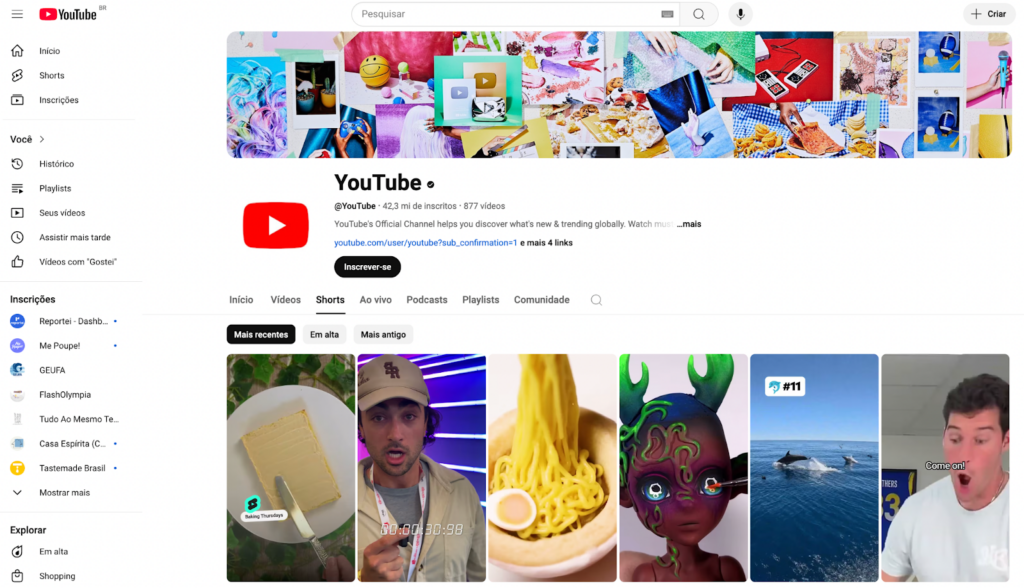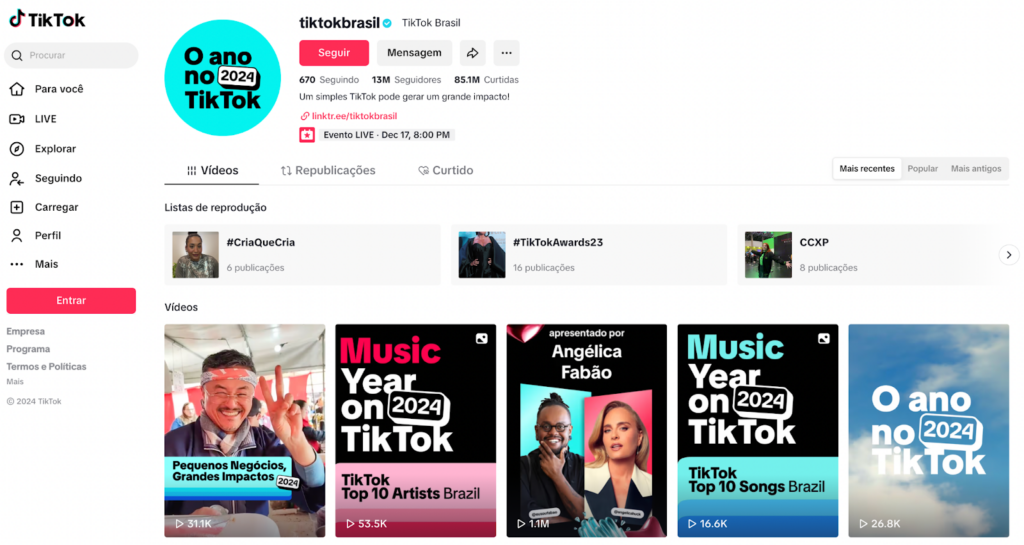Check out the full comparison of objectives, audiences, features, and other key aspects to help you decide between Shorts and TikTok for your video strategy
With the rise of short-form video consumption, it’s no surprise that YouTube Shorts and TikTok have become top choices for businesses and content creators looking to reach thousands of people in a short amount of time.
But the key question is: which platform should you invest your resources, time, and creativity in?
In this article, we’ll compare the features of each platform, their advantages and disadvantages, and help you determine which one best aligns with your goals—or whether it’s worth leveraging both to maximize your reach. Keep reading!
The Role of Shorts and TikTok in Digital Strategies
Today, short-form video content is one of the key pillars of digital marketing strategies.
With audiences becoming increasingly impatient and a vast amount of information competing for attention online, concise and engaging videos have a higher chance of capturing user interest.
In this landscape, YouTube Shorts and TikTok stand out as major platforms, offering creative possibilities and high viral potential.
Shorts is a feature within YouTube, launched as a response to TikTok’s rapid growth.
As an extension of the world’s most popular video platform, Shorts benefits from YouTube’s entire ecosystem, from Google integration and monetization options to strong organic reach.

TikTok: A Global Phenomenon in Social Media and Brand Engagement
Originating in China, TikTok quickly captured the attention of young audiences and expanded worldwide, becoming a social media and brand engagement phenomenon.
For businesses and content creators, both platforms offer unique opportunities to connect with audiences, experiment with creative formats, and, most importantly, boost brand awareness.
However, the main challenge lies in deciding where to focus time, energy, and resources. The answer depends on understanding how each platform works, what sets them apart, and how audiences interact with content in each environment.
Shorts or TikTok: Understanding the Key Differences
Before diving into the pros and cons of each platform, it’s essential to grasp the fundamental differences between YouTube Shorts and TikTok.
These differences go beyond simply who came first or who has more active users. Each platform has distinct characteristics in terms of audience, creative tools, and content distribution algorithms, as we’ll explore below.
Value Proposition
- YouTube Shorts serves an audience already accustomed to long-form content while offering short videos as an alternative.
- For creators, this means the advantage of integrating traditional YouTube videos with Shorts, allowing them to reach different audience segments within a single account.
On the other hand, TikTok is entirely focused on short-form videos. The platform is known for viral trends, dance challenges, lip-syncing, and creative formats that have spread globally.
This makes TikTok ideal for brands looking to connect with younger audiences or those who prefer dynamic, entertaining content as part of their daily routine.

Recommendation Algorithm
- YouTube Shorts leverages part of YouTube’s recommendation algorithm, which prioritizes relevance, watch time, and engagement. However, the platform is still refining its system to better determine which content to promote.
- TikTok’s algorithm is widely recognized for its high efficiency in promoting engaging content, regardless of the creator’s follower count or channel size.
Unlike YouTube, TikTok’s recommendations are driven by user interactions (likes, comments, watch time) and viewing history, making it easier for smaller creators to go viral.
Creation Tools and Features
- YouTube Shorts offers basic editing tools, such as trimming, captions, and multi-clip recording.
- Compared to TikTok, Shorts is more limited in terms of filters, effects, and audio options.
Meanwhile, TikTok excels with a vast selection of filters, special effects, soundtracks, and music that can be seamlessly integrated. The platform also drives content trends and challenges, providing ongoing inspiration for creators and influencers.
Target Audience
- YouTube Shorts reaches YouTube’s general community, spanning all age groups and niches, from children to older adults.
- This can be advantageous for established YouTube creators, as Shorts allows them to engage their existing audience while attracting new viewers.
In contrast, TikTok is more closely associated with younger audiences (Gen Z and millennials). However, the platform has seen growing adoption among older demographics, especially since the pandemic.
For brands, TikTok is ideal for creativity, humor, and fast-paced content, making it a strong choice for viral marketing.
In conclusion, understanding these differences is the first step in deciding whether TikTok or YouTube Shorts fits your strategy.
Below, check out a selection of the main advantages and disadvantages of each platform to determine which best suits your needs.
Main Advantages and Disadvantages of YouTube Shorts
YouTube Shorts has become an important tool for creators looking to leverage traffic from the world’s largest video platform. When evaluating some of its key advantages, we can highlight:
- Integration with the YouTube ecosystem: If you already have an established channel, you can combine long-form content with Shorts to enhance your organic reach. Additionally, the ability to direct viewers from short videos to longer ones helps increase overall watch time on your channel.
- Monetization tools: As part of YouTube, Shorts benefits from financial incentive programs and is expected to introduce more robust monetization opportunities in the future.
- SEO: Being part of the Google ecosystem provides an indexing advantage in search results. As Shorts continues to evolve, short videos may appear more frequently in Google search results, increasing channel exposure.
On the other hand, there are disadvantages that need to be considered:
- Limited editing features: Compared to TikTok, Shorts still lacks the same variety of native filters, effects, and creative tools.
- Direct competition: As Shorts continues to grow in popularity, gaining visibility in the dedicated tab can be challenging. Your content will compete with a vast number of short videos, requiring clear differentiation strategies.
Main Advantages and Disadvantages of TikTok
TikTok has revolutionized the short-form video market and remains one of the most popular platforms worldwide. Among its advantages, we can highlight:
- High viral potential: Its algorithm favors content that generates quick engagement, allowing small creators or emerging brands to gain massive exposure in a short time, reaching millions of views without needing a large follower base.
- Diverse formats and interactions: The platform encourages creativity through challenges, collaborations, and filters that make content production dynamic and engaging. This motivates users to participate in trends and develop their own style.
- Highly engaged community: TikTok stands out for its intense user engagement. Fun and relevant videos receive massive likes, comments, and shares, creating a “snowball effect” for those who get their content strategy right.
However, there are also some disadvantages:
- Lower retention time: Many users scroll through videos quickly, making it harder to convey complex or in-depth messages.
- Entertainment-focused: While educational and informational content exists, TikTok is still largely associated with trends, humor, and entertainment. As a result, more “serious” brands may need to significantly adapt their tone of voice to succeed on the platform.
Shorts or TikTok: When to Use Each Platform?
Now that we understand the characteristics of both platforms, the decision between Shorts or TikTok should take into account your marketing objectives and audience preferences.
YouTube Shorts is a strong choice if:
- You already have a YouTube channel with a loyal subscriber base and want to expand your reach.
- You plan to leverage integration with long-form videos and strengthen your channel’s relevance.
- You want to optimize for Google SEO and reach users searching for specific keywords.
TikTok is worth investing in if:
- Your audience is mostly young or accustomed to consuming fast-paced entertainment content.
- You want to capitalize on trends, challenges, and creative formats to boost virality.
- You’re looking for a more dynamic platform with advanced effects and greater interaction opportunities with other creators.
In some cases, using both platforms is the best approach. Diversifying your channels allows you to reach different audience segments and test content strategies across multiple formats.
Additionally, creative content from TikTok can be adapted for Shorts, and vice versa, as long as you carefully adjust the tone, language, and editing style to fit each platform’s best practices.
Performance Analysis on YouTube Shorts and TikTok
Whether you choose TikTok or Shorts, tracking performance metrics should be an essential part of your strategy.
Both platforms offer built-in analytics tools to measure views, likes, comments, shares, and audience retention. Here’s how they work:
- YouTube Shorts: Within YouTube Studio, you can track video performance, audience retention, engagement, and how users discovered your content. You can also cross-reference these insights with long-form video analytics to understand the synergy between formats.
- TikTok Analytics: Allows you to monitor views, audience demographics, engagement rates, and even geographic reach. These insights help tailor content to audience preferences and refine targeted ad campaigns.
To gain a more comprehensive view, it’s beneficial to consolidate these metrics into a single tool.
That’s where Reportei can help. Our platform enables integrated analysis across multiple channels, making it easier to compare YouTube Shorts and TikTok performance alongside other social media and digital marketing strategies.
This way, you can identify correlations between short-form video performance and other key actions, such as website traffic, lead generation, and overall campaign success.
Try our free trial and see how Reportei can help make your social media analytics and strategy more effective!



